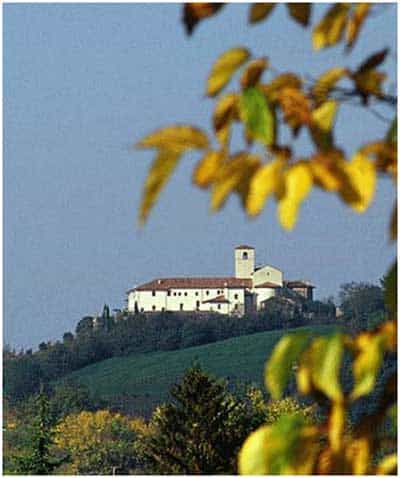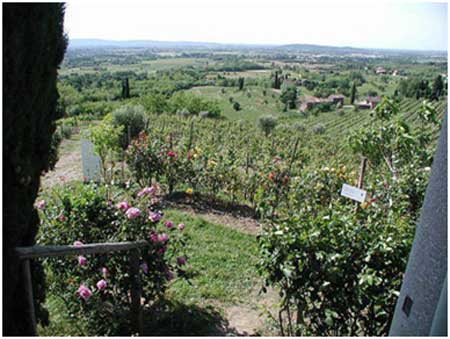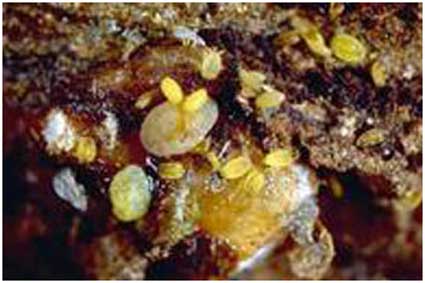By Judy J. Pinegar

The Friuli-Venezia Giulia region is an overlooked region in the Italian tourism scene, but it produces some exceptional wines. The origins of these wines date back to the middle ages (1066 to 1485), when the area was important in the Mediterranean spice route from the Byzantine Empire to the trading center of Venice. Travelers through the area brought grape vines from Macedonia and Anatolia. Under the Hapsburg reign, the German and French grape varieties were brought in. Even today, the Friuli-Venezia Giulia wine region is an area close to Austria and Slovenia. Due to this positioning, the region has a unique blend of Italian, Slavic and Austrian cultures and foods. But the wine, especially the white wine is special.
The Abbey of Rosazzo is located in the Coli Orientali (eastern hills) of Friuli in an isolated area to the northeast of Manzano (famous for the production of chairs), around twenty kilometres from Udine and ten kilometres from the Slovenian border. The origins of the over one thousand year old abbey are still not fully known. Proof to the early origins of winemaking as well as the importance of the craft to the society comes from a document in the abbey dated January 20, 1341 that reads: “The Patriarch Bertrando has threatened the excommunication of several people, who after having occupied a wood belonging to the Abbey of Rosazzo did not want to plant vines”. Shocking!

Both photos and quote courtesy of The Abbey of Rosazzo http://www.abbaziadirosazzo.it
In the pictures of the Abbey note the proximity of the vines and roses. Even today in California on a wine tour you often see a single rose planted at the end of each row, traditionally the roses are the grape growers early warning system. Powdery mildew is a fungus affects both plants, but roses are much more sensitive to the disease. So if the roses are infected, it is time to spray the grapes with sulfur or other fungicides that are used today. Roses also warn of other diseases, and harbor beneficial insects that help kill other insects in the grapes. And they are beautiful! The Abbey can be visited, with some limited rooms, but visit the cellar as it is one of the oldest in Friuli, dating back to the end of the thirteenth century with the Benedictine monks.
The Friuli-Venezia Giulia region is bordered by the Alps to the north separating it from Austria. Slovenia borders the region on the east and the Italian region of Veneto forms the western border. The northern half is very mountainous and gives way to flatter terrain on the way to the sea. The climate is distinguished with very warm days and chilly nights that help maintain a balance in the grape between acidity and sugar levels and allows the grapes a long, slow growing season. In summertime the average temperature is around 73 °F (22.8 °C) with rainfall averaging 60 inches (1,530 mm). Harvest normally takes place in September. The names of Friuli vineyards and wine estates often include the word ronco (plural ronchi), which is the Friulian word for a terraced hillside.(Last three sentences are referenced from: The Wine Bible, Workman Publishing 2001)
Prior to phylloxera insect epidemic in the late 19th century, the over 350 grape varieties were grown in the Friuli-Venezia Giulia wine region. A document in the Abbey lists some of the grape varieties as Ribolla Gialla, Piccolit and Pignolo. The Phylloxera was brought to Europe when avid botanists in England collected specimens of grape vines in the 1850s. Phylloxera is a almost microscopic pale yellow sap sucking insect, related to aphids. Because phylloxera is native to North America, the native grape species there was at least partially resistant. By contrast, the European wine grapes were susceptible to the insect including the grapes in Friuli-Venezia Giulia. Killing most of the vines, winemaking was extremely slowed until the 1970s. People began grafting the European varietals on to American raised rootstock, Then luckily, the international popularity of Pino Grigio 1980s and 1990s help to change the dynamic of Friuli-Venezia Giulia winemaking.

Prior to this time vineyard owners sold their grapes in bulk co-operative wineries that would blend the grapes together. But Mario Schiopetta, a pioneering winemaker in the hills of Capriva del Friuli founded his now legendary estate in 1965 and began producing a range of fresh, crisp white wines that set the bar for high-quality white wine production in Italy and put Friuli on the map as one of the world’s great white wine regions.
Before starting his winery, Mario traveled to Germany and France to explore how wines were made there. He applied German technology and French finesse to his winemaking, becoming the first to bring temperature-controlled fermentation to the Friuli-Venezia Giulia wine region. He was also one of the first to ferment in stainless steel tanks (rather than oak barrels), which kept the wines fresh and crisp. Since Mario’s passing in 2003, his three children Carlo and Giorgio and Maria Angela Schiopetta, have been running the family business. Most other white winemakers began using Mario’s techniques, leading to the increasing quality of wines in this area.
Please help to keep this blog going
Let us Sell or help you buy your new home or land
John J. O’Dell Realtor® GRI
O’Dell Realty
(530) 263-1091
Email John
BRE# 00669941
